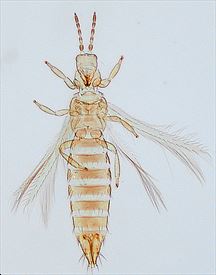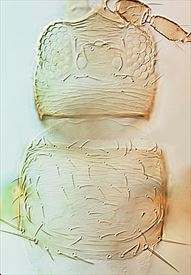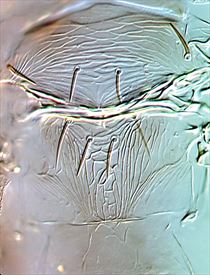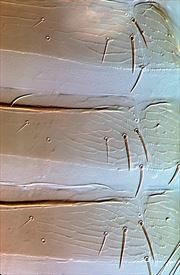
Antenna



Meso & metanotum

Meso & metanotum

Tergites & pleurotergites

Tergites & pleurotergites

Tergite VIII

Tergites VII-IX
Distinguishing features
Both sexes fully winged. Female colour varying from yellow to brown, depending largely on temperatures during development; ocellar pigment never red, usually grey; antennal segments III–IV brown with basal half pale; fore wings pale. Antennae 7-segmented. Head wider than long, ocellar setae pair III small and arising on anterior margins or just within triangle; postocular setae pairs I–III about equal to ocellar setae III in length. Pronotum posterior margin with 3 (or 4) pairs of setae. Mesonotum without anterior pair of campaniform sensilla. Metanotum irregularly reticulate medially with lines converging to midpoint near posterior margin; median setae short and arising behind anterior margin; campaniform sensilla absent. Fore wing first vein usually with 4 (varying from 2–6) setae on distal half, second vein with row of about 15 setae. Tergite II with 3 lateral marginal setae; posterior margin of tergite VIII with complete comb of long slender microtrichia; tergite IX lacking pair of campaniform sensilla on anterior half; pleurotergites without discal setae, sculpture bearing rows of fine microtrichia. Sternites without discal setae.
Male small and yellow; tergite VIII with marginal comb represented by a few irregular microtrichia; sternites III–V with narrow transverse pore plate.
Related species
There are 13 species of the genus Thrips recorded from New Zealand, out of a total of 280 species worldwide (Mound & Masumoto, 2005). Many of these species have the antennae clearly 7-segmented, whereas others have 8 segments. All members of Thrips genus have paired ctenidia on the tergites, and on tergite VIII these are postero-mesad to the spiracles, and they also lack ocellar setae pair I in front of the first ocellus. In contrast, Frankliniella species have ctenidia on tergite VIII antero-lateral to the spiracles, and a pair of setae is always present in front of the first ocellus. T. tabaci, the Onion Thrips, is characterised by having pleurotergites with a dense covering of closely spaced rows of microtrichia, also a few similar microtrichial rows laterally on the tergites. Moreover, this species lacks paired campaniform sensilla on the anterior half of the ninth abdominal tergite. The lack of red pigment beneath the three ocelli on the head usually facilitates recognition of T. tabaci. However, there is considerable molecular diversity among populations that are identified on morphological grounds as this species (Westmore et al. 2013).
Biological data
The Onion Thrips feeds and breeds in the flowers and on the leaves of many different plant species. It is particularly abundant on Allium, cereals, potatoes, vines and glasshouse crops. Feeding damage includes silvering of leaves, but is is also a vector of tospoviruses, particularly potatoes in Tasmania. Despite its pest status, it can be a beneficial as it is also a predator of some mite species. Males are known in eastern Mediterranean countries and also in New Zealand, but not in Australia (Westmore et al. 2013).
Distribution data
Found throughout New Zealand, T. tabaci is common worldwide, although it is rare in the wet tropics. Presumably it was originally from the eastern Mediterranean area where males occur.
Family name
THRIPIDAE, THRIPINAE
Species name
Thrips tabaci Lindeman
Original name and synonyms
Thrips tabaci Lindeman, 1889: 61
Limothrips allii Gillette, 1893: 15
Thrips communis Uzel, 1895: 176
Thrips annulicornis Uzel, 1895: 177
Thrips pulla Uzel, 1895: 177
Thrips obsoleta Uzel. 1895: 187
Thrips bremnerii Moulton, 1907: 59
Parathrips uzeli Karny, 1907: 48
Thrips bicolor Karny, 1907: 49
Thrips brachycephalus Enderlein, 1909: 441
Thrips hololeucus Bagnall, 1914: 24
Thrips adamsoni Bagnall, 1923: 58
Thrips debilis Bagnall, 1923: 60
Thrips mariae Cotte, 1924: 2
Thrips frankeniae Bagnall, 1926: 654
Thrips seminiveus Girault, 1926: 1
Thrips tabaci f. irrorata Priesner, 1927: 436
Thrips tabaci f. atricornis Priesner, 1927: 437
Thrips tabaci f. nigricornis Priesner, 1927: 436
Thrips dorsalis Bagnall, 1927: 576
Thrips shakespearei Girault, 1927: 1
Thrips indigenus Girault, 1929: 29
Thrips dianthi Moulton, 1936: 104
Ramaswamiahiella kallarensis Ananthakrishnan, 1960: 564
References
Hoddle MS, Mound LA, Paris DL (2012) Thrips of California 2012. CBIT Publishing, Queensland. http://keys.lucidcentral.org/keys/v3/thrips_of_california/
Thrips_of_California.html
Mound LA & Masumoto M (2005) The genus Thrips (Thysanoptera, Thripidae) in Australia, New Caledonia and New Zealand. Zootaxa 1020: 1–64
Mound LA, Tree DC, Paris D. (2012) Oz Thrips – Thysanoptera in Australia. http://www.ozthrips.org/
Mound LA & Walker AK (1982) Terebrantia (Insecta: Thysanoptera). Fauna of New Zealand 1: 1–113.
Moritz G, Mound LA, Morris DC & Goldarazena A (2004) Pest thrips of the world – visual and molecular identification of pest thrips. CD-ROM published by CBIT Brisbane. http://www.cbit.uq.edu.au/software/pestthrips/default.htm
Palmer JM (1992) Thrips (Thysanoptera) from Pakistan to the Pacific: a review. Bulletin of the British Museum (Natural History) Entomology 61: 1–76.
Westmore GC, Poke FS, Allen GR &Wilson CR (2013) Genetic and host-associated differentiation within Thrips tabaci Lindeman (Thysanoptera: Thripidae) and its links to Tomato spotted wilt virus-vector competence. Heredity 111: 210–215.